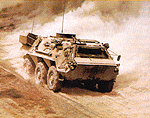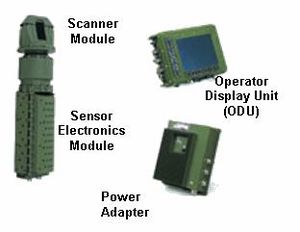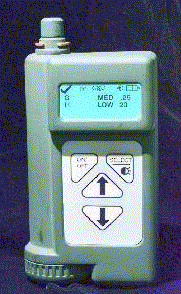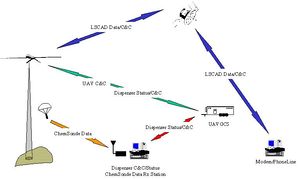Materials MASINT
| This article may be deleted soon. | ||
|---|---|---|
Materials MASINT involves the collection, processing, and analysis of gas, liquid, or solid samples. This discipline is critical in defense against weapons of mass destruction (i.e., chemical, biological, and radiological threats (CBR), or nuclear-biological-chemical (NBC)), as well as more general safety and public health activities. It should be distinguished from the discipline of technical intelligence, which does overlap this discipline. To understand the difference, consider that there are multiple ways to understand the propellant of a new enemy weapon. A technical intelligence analyst would work with a captured example of the weapon, or at least pieces of it, to come to that understanding. The technical intelligence analyst might eventually fire the weapon under controlled circumstances. In contrast, a materials MASINT analyst would collect information on the weapon principally through remote sensing directed on the enemy's use of the weapon. The materials MASINT analysis may learn more about the way the enemy actually uses the weapon, while the technical intelligence analyst may understand more about the manufacture, maintainability, and skills required to use the weapon. It is one of the six major disciplines generally accepted to make up the field of measurement and signature intelligence (MASINT). with due regard that the MASINT subdisciplines may overlap, and MASINT, in turn, is complementary to more traditional intelligence collection and analysis disciplines such as Signals intelligence (SIGINT), Imagery intelligence (IMINT), or Human Intelligence (HUMINT). The results of MASINT are technically derived information that – when collected, processed, and analyzed by dedicated MASINT systems – results in intelligence that detects, tracks, identifies, or describes the signatures (distinctive characteristics) of fixed or dynamic target sources. MASINT was recognized as a formal intelligence discipline in 1986. [1]. Materials intelligence is one of the major MASINT disciplines[2]. Specific techniques may overlap with the six major conceptual disciplines of MASINT defined by the Center for MASINT Studies and Research, which divides MASINT into Electro-optical, Nuclear, Geophysical, Radar, Materials, and Radiofrequency disciplines.[3] DisciplinesMASINT is made up of six major disciplines, but the disciplines overlap and intertwine. An example of the interaction is "imagery-defined MASINT (IDM)". In IDM for materials MASINT, a MASINT application would measure an image obtained through imagery intelligence methods, pixel by pixel, and try to identify the physical materials, or types of energy, that are responsible for measurements produced pixels or groups of pixels, and if they differ from known signatures. When the signatures are then correlated to precise geography, or details of an object, the combined information becomes something greater than the whole of its IMINT and MASINT parts. The Center for MASINT Studies and Research[3] breaks MASINT into: Samples for materials MASINT can be collected by automatic equipment, such as air samplers, indirectly by humans. Samples, once collected, may be rapidly characterized or undergo extensive forensic laboratory analysis to determine the identity and characteristics of the sources of the samples. Materials CollectionThe Fuchs (German for Fox) NBC reconnaissance vehicle has been an example of the tactical state of the art for land warfare. This system, in various versions, is used by Germany, the Netherlands, Saudi Arabia, Norway, the UK, the US and UAE. German forces first used it in Kosovo, but the US bought the German units for use in Desert Storm, after modifying it into the XM93. [4] This vehicle can keep up with moving troops, detecting liquid and vapor hazards. Newer versions have enhanced radiation survey, meteorological, chemical, and biological sensors, as well as computer support. The newer systems are intended for both a CBR battlefield and release other than attack (ROTA) events. ROTA events include industrial accidents as well as terrorist incidents. Its computer systems, complemented by meteorological information and signature information on the CBR agents, can predict propagation and report it using tactical symbols and NBC reports NATO standards ATP45(B).In the U.S. Army, however, it is being replaced by the M1135 nuclear, biological, chemical reconnaissance vehicle For airborne sample collection, the pattern increasingly is to use Unmanned Aerial Vehicles (UAV). Still, for long-range missions, a U-2 or reconnaissance version of the C-135 (US) or Nimrod (UK) might be used. Chemical Materials MASINTThere are a wide range of reasons to do chemical analysis of substances to which one's own forces are exposed, as well as learning the nature and signatures of a wide range of chemicals used by other nations. Ammunition, Explosive, and Rocket Propellant AnalysisTraditional chemical analysis, as well as techniques such as spectrometry using remote laser excitation, are routine parts of materials intelligence, in contrast to TECHINT evaluating the firing of the material. Chemical Warfare and Improvised Chemical DevicesSince the advent of chemical warfare in the First World War, there has been an urgent operational requirement for detecting chemical attacks. Early methods depended on color changes in chemically treated paper, or even more lengthy and insensitive manual methods. To assess a modern chemical sensor, several parameters can be combined to create a figure of merit called the receiver operating characteristic (ROC). These parameters are sensitivity, probability of correct detection, false positive rate and response time. Ideally, the device can have the parameters adjusted for specific situation. It may be more important that the device has a low false positive rate (i.e., is selective, with a low rate of false negatives) or is maximally sensitive, which means accepting false positives. ROC curves are commonly drawn to show sensitivity as a function of false positive rate for a given detection confidence and response time. Too high a false positive rate, without an operator that understands the context, can cause real alarms to be ignored. In an environment where terrorists may improvise, it is not enough to detect formal chemical weapons, but at least 100 highly toxic industrial chemicals from which a weapon could be improvised.[5]. Modern chemical weapon detection is highly automated. One technique involves continual sampling of air through a nondispersive infrared analyzer. More complex instrumentation, such as gas chromatographs coupled to mass spectrometers, are standard laboratory techniques that need to be modified for the field. XM93 Fuchs chemical analysis capability is built around an MM-1 mobile mass spectrometer and air/surface sampler. The US version adds the M43A1 detector component of the first US automatic chemical detector, the 1970s vintage M8. After Operation Desert Storm field experience, where troops had overestimated the detection capability of the highly selective, but not extremely sensitive, MM-1. A Remote Sensing Chemical Agent Alarm (M21), which is a Fourier Transform Infrared Spectrometer, a form of infrared spectroscopy, that exploits the property that organophosphates, to which the nerve agents belong, have a distinctive signature. The M21 detects chemical agent hazards at line-of-sight distance up to five kilometers away. Adding the M21 has improved the Fox’s vapor detection capabilities and provides more advance warning of a possible vapor chemical warfare agent hazard. The M21 does not know if it is sensing a specific chemical warfare such as Sarin or an organophosphate insecticide such as malathion[6]. This means that a sensor may give false positives. Malathion, for example, while not as toxic as a true chemical weapon, very well could be used by terrorists or could be spilled by an accident, in a concentration that may be dangerous. The insecticide parathion is sufficiently toxic that it might be tried as an improvised chemical attack. More specific chemical detectors, however, have tended to have either the signatures of chemical weapons or of industrial chemicals. The M21 will be succeeded by the Artemis, formerly the Joint Service Lightweight Standoff Chemical Agent Detector (JSLSCAD), which, as opposed to the narrow field of view of the M21, has 360 degree ground coverage and 60 degree air coverage. [5] The Navy is the program manager for Artemis[7]. It is based on LASER radar (LIDAR), detects chemical agent aerosols, vapor, and surface contamination, and gives range from the sensor to the threat. Artemis is being made by a team from Intelletic, Honeywell Technology Center, OPTRA, Inc. and Recon/Optical, Inc. Artemis is not man-portable, so the Army is managing a program for Automatic Chemical Agent Detector and Alarm (ACADA), which will replace the existing M8A1, and operate with the M279 Surface Sampler. This system can be used on helicopters and ships as well as in vehicles or on a ground tripod. The handheld Improved Chemical Agent Monitor (ICAM) is a hand-held device for monitoring specific chemical agent (i.e., mustard and nerve gas) contamination on surfaces. It works by by sensing the molecular ions of specific mobilities (time-of-flight), with software to help analysis. JCAD, the Joint Chemical Agent Detector, is a pocket-sized detector that will detect, identify and quantify chemical agents, in real time, on ships and aircraft. It uses surface acoustic wave technology. The Air Force manages the contract with BAE. Being built by TRW for the US Marine Corps, the Joint Service Lightweight Nuclear, Biological, Chemical Reconnaissance System (JSLNBCRS) is vehicle-mounted in the HMMWV and LAV. It will detect chemical agents using mass spectrometry. The Proengin AP2C handheld chemical warfare (CW) agent detector uses flame spectroscopy. It had been restricted to CW agents (AP2C detector) or industrial compounds (toxic industrial materials (TIMS) detector). The newer A4C can detect true chemical agents, as well 49 of 58 chemicals on NATO’s toxic industrial chemical (TIC)/TIM list while avoiding common false positives such as methyl salicylate (synthetic oil of wintergreen)[8]. The emitted light is sensed through element-specific filters (AP2C) or on height sensitive spectrometer. The latter directs the light to a diffraction grating on a multi-photodiode detector. A different approach than troop protection may be appropriate for wide-area chemical survey. The Chemical Agent Dual-Detection Identification Experiment (CADDIE) [9] was developed by the US Navy as a feasibility demonstration of a Unmanned Aerial Vehicle using onboard sensors to locate a suspicious cloud, and then drop disposable ChemSonde sensors into it. .This system demonstrated several characteristics of modern MASINT: a broad-look capability, as with "pushbroom" radar, and then a close-look with the disposable sensors. The sensors are released from an off-the-shelf ALE-47 Countermeasure Dispenser System, which normally holds chaff, flares, or expendable jammers. Biological Materials MASINTIn modern materials analysis, the line between chemical and biological methods can blur, since immunochemistry, an important discipline, uses biologically created reagents to detect chemical and biological substances. Key characteristics of a technique that can be adapted to field use, as opposed to slow and labor-intensive methods such as culture-based identification, depend on a probe that recognizes and reacts with a molecule, receptor, or other feature of the organism, and a separate transducer recognizes the positive results of the probe and provides it to the operator. The combination is what determines analysis time, sensitivity and specificity. The major families of probe methods are: nucleic acid, antibody/antigen binding, and ligand/receptor interactions. Transducer techniques include: electrochemical, piezoelectric, colorimetric, and optical spectrometric systems. [10]. Biological Warfare DetectionA wide range of analytical tools are used in modern microbiological laboratories, and many can be adapted to field use Some that have been adapted include[11]:
The original Fuchs, and the slightly modified version fielded by the US in 1991, had biological protection for the crew, but no biological analysis capability. An interim version, the Fuchs biological reconnaissance system (BRS), continually monitored outside air for particulate matter that could be biological weapons, and, if detected [12] would transfer them to a biological safety cabinet (i.e., sealed glove box) for analysis using a variety of genetic and immunologic tests. This interim version, however, involves a NBC Field Laboratory set of vehicles and shelters, not a single mobile system:
The entire system is transportable by air, ship, or truck (the latter with the Command and Sampling Vehicle self-deploying). The latest Fuchs 2 version, ordered by the UAE in March 2005 for delivery in 2007, will feature an integrated equipment set, to go inside the glove box, for detecting biological weapons. Analytical methods include ELISA, polymerase chain reaction (PCR), Liquid chromatography-mass spectrometry (LC-MS), and [[High-performance liquid chromatography |high performance (also called high pressure) liquid chromatography (HPLC). It should be noted that these methods rarely can instantly identify a biological agent, but can give preliminary results, with an adequate sample, in minutes to hours. The Fuchs 2 also has weather sensors that can help predict the propagation of contaminants. See weather MASINT. The US Army is implementing an interim Biological Integrated Detection System (BIDS) made by the team Bio Road, Bruker Analytical Systems, Environmental Technologies Group ,Harris Corp, and Marion Composites (CBDP 2001). Also under the Army is the Joint Biological Point Detection System (JBPDS), which will succeed the Army's BIDS. It will also replace the Navy IBADS and give initial capability to the Air Force and Marines. It has "complementary trigger, sampler, detector and identification technologies to rapidly and automatically detect and identify biological threat agents. Multiple agents will be detected in a maximum of 15 minutes. JBPDS is built by Batelle and Lockheed Martin. China also has a BW detection capability.[13] "In keeping with the definition of BW as "public health in reverse," PRC writings on the subject treat the matter more in terms of infectious disease control, an approach that is standard everywhere. As one would expect, considerable amount of research has been conducted in China on potential BW agents including tularemia, Q fever, plague, anthrax, Western Equine Encephalitis, Eastern Equine Encephalitis, and psittacosis, among others. Some specialized equipment has also been fielded in some unspecified numbers to counter the threat of BW to PLA troops:
Biological Counterproliferation MASINTOne of the challenges of preventing the proliferation of biological warfare capability is verifying that a legitimate bioengineering facility is not producing weapons. Since many completely legal processes involve trade secrets, production facilities can be reluctant to allow detailed inspection and sampling of what might be a commercial advantage. The Henry L. Stimson Center has done a good deal of conceptual work on an inspection regimen, in which inspectors would use biological tests that looked for genetic materials associated with known weapons [14]. Even when a potential weapon, such as Clostridium botulinum (i.e., [[botulism[[ exotoxin (Botox or "botulinus toxin") is discovered, the amounts or preparation may be such that it can be established the use is for legitimate medical, veterinary, or research applications. These approaches to detecting violations of "dual use" also have the potential for recognizing epidemic organisms in a public health context. Personnel detectorsA Vietnam-era sensor, the XM2, generally known as the "people sniffer", detected ammonia concentrations in air, which indicated the presence of groups of people or animals. While it was sensitive, but not selective for people, many water buffalo became targets. Nevertheless, it was considered the best sensor used by the 9th Infantry Division, because, as opposed to other MASINT and SIGINT sensors, it could give helicopter-borne troops real-time detection of targets [15] The authors compared the timeliness of a range of sensors
References
|
||
- Articles for deletion April
- CZ Live
- Military Workgroup
- Analytical Chemistry Subgroup
- Intelligence Subgroup
- Measurement and signatures intelligence Subgroup
- Articles written in American English
- All Content
- Military Content
- Military tag
- Analytical Chemistry tag
- Intelligence tag
- Measurement and signatures intelligence tag





